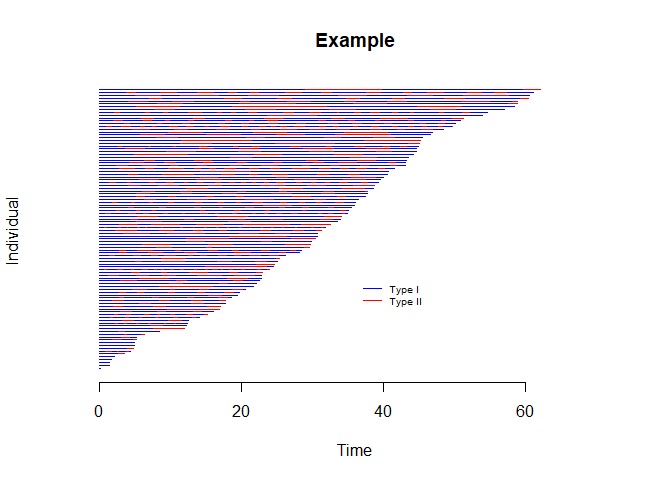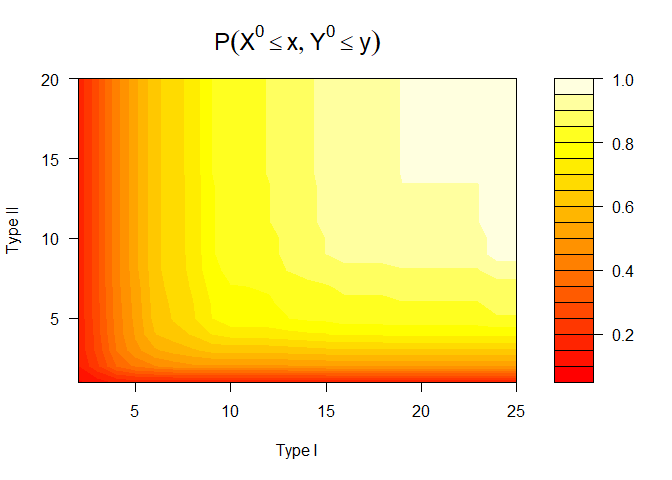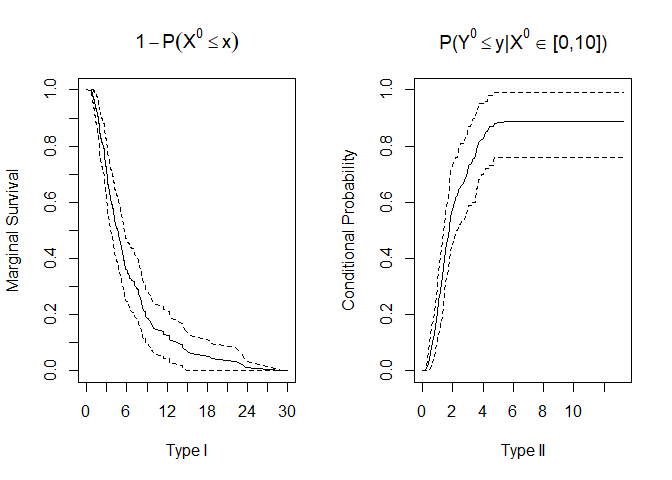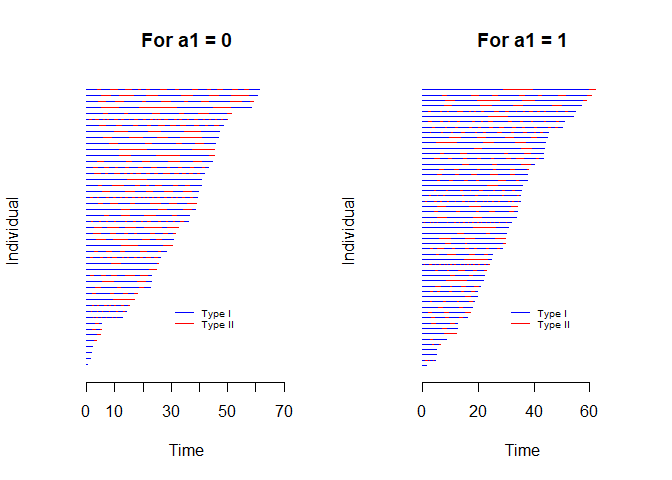Alternating recurrent event data arise frequently in biomedical and social sciences where two types of events such as hospital admissions and discharges occur alternatively over time. BivRec implements a collection of nonparametric and semiparametric methods to analyze such data.
The main functions are:
- bivrecReg: Use for the estimation of covariate effects on the two
alternating event gap times (Xij and Yij) using semiparametric methods.
The method options are “Lee.et.al” and “Chang”.
- bivrecNP: Use for the estimation of the joint cumulative distribution
funtion (cdf) for the two alternating events gap times (Xij and Yij) as
well as the marginal survival function for type I gap times (Xij) and
the conditional cdf of the type II gap times (Yij) given an interval of
type I gap times (Xij) in a nonparametric fashion.
The package also provides options to simulate and visualize the data and results of analysis.
BivRec depends on the following system requirements:
- Rtools. Download Rtools 35 from
https://cran.r-project.org/bin/windows/Rtools/
Once those requirements are met you can install BivRec from github as follows:
#Installation requires devtools package.
#install.packages("devtools")
library(devtools)
#install_github("SandraCastroPearson/BivRec")This is an example using a simulated data set.
# Simulate bivariate alternating recurrent event data
library(BivRec)
#> Registered S3 method overwritten by 'BivRec':
#> method from
#> plot.formula graphics
set.seed(288)
sim_data <- simBivRec(nsize=100, beta1=c(0.5,0.5), beta2=c(0,-0.5), tau_c=63, set=1.1)
head(sim_data)
#> id epi xij yij ci d1 d2 a1 a2
#> 1 1 1 1.886882 1.4385977 5.218676 1 1 0 0.01429619
#> 2 1 2 1.459066 0.4341303 5.218676 1 0 0 0.01429619
#> 3 2 1 2.812824 0.7359517 18.667124 1 1 1 0.74366631
#> 4 2 2 3.957610 1.0279152 18.667124 1 1 1 0.74366631
#> 5 2 3 3.966836 0.8669458 18.667124 1 1 1 0.74366631
#> 6 2 4 3.489983 1.4055131 18.667124 1 1 1 0.74366631
# Create a bivrecSurv object
bivrec_object <- with(sim_data, bivrecSurv(id, epi, xij, yij, d1, d2))
# Plot gap times
plot(bivrec_object, main="Example", type = c("Type I", "Type II"))Nonparametric Analysis
# Apply the nonparametric method of Huang and Wang (2005) and visualize joint, marginal and conditional results
library(BivRec)
npresult <- bivrecNP(response = bivrec_object, ai=1,
u1 = seq(2, 25, 1), u2 = seq(1, 20, 1), conditional = TRUE,
given.interval = c(0, 10), level = 0.99)
#> [1] "Estimating joint CDF and marginal survival"
#> [1] "Estimating conditional cdf with 99% confidence interval using 200 bootstrap samples"
head(npresult)
#>
#> Joint CDF:
#> x y Joint Probability SE Lower .99 Upper .99
#> 1 2 1 0.0908710 0.02354341 0.03022720 0.1515148
#> 2 2 2 0.1481150 0.03075241 0.06890205 0.2273279
#> 3 2 3 0.1579445 0.03134974 0.07719294 0.2386961
#> 4 2 4 0.1579445 0.03134974 0.07719294 0.2386961
#> 5 2 5 0.1607501 0.03132463 0.08006321 0.2414370
#> 6 2 6 0.1607501 0.03132463 0.08006321 0.2414370
#>
#> Marginal Survival:
#> Time Marginal Survival SE Lower .99 Upper .99
#> 1 0.5177089 0.9993266 6.763374e-05 0.9991524 0.9995008
#> 2 0.5743254 0.9986532 6.729472e-04 0.9969198 1.0000000
#> 3 0.5776458 0.9979798 1.340786e-03 0.9945262 1.0000000
#> 4 0.6523116 0.9974988 2.009200e-03 0.9923234 1.0000000
#> 5 0.7016157 0.9941318 2.087441e-03 0.9887549 0.9995087
#> 6 0.7059578 0.9936508 3.901686e-03 0.9836007 1.0000000
#>
#> Conditional CDF:
#> Time Conditional Probability Bootstrap SE Bootstrap Lower .99
#> 1 0.0000 0.0000 0.0000 0
#> 2 0.0669 0.0000 0.0000 0
#> 3 0.1337 0.0000 0.0000 0
#> 4 0.2006 0.0013 0.0012 0
#> 5 0.2675 0.0066 0.0049 0
#> 6 0.3344 0.0155 0.0085 0
#> Bootstrap Upper .99
#> 1 0.00
#> 2 0.00
#> 3 0.00
#> 4 0.00
#> 5 0.02
#> 6 0.04
plot(npresult)# To save individual plots in a pdf file un-comment the following line of code:
# pdf("nonparam_jointcdfplot.pdf")
# plotJoint(npresult)
# dev.off()
# pdf("nonparam_marginalplot.pdf")
# plotMarg(npresult)
# dev.off()
# pdf("nonparam_conditionaplot.pdf")
# plotCond(npresult)
# dev.off()Semiparametric Regression Analysis
#Explore how the response changes by levels of a categorical covariate using a plot.
plot(x = bivrecSurv(id, epi, xij, yij, d1, d2) ~ a1 + a2, data = sim_data,
type = c("Type I", "Type II"))
#> [1] "a2 not used - either continuous or had more than 6 levels."
#> [1] "Original number of subjects: 100. Subjects for plots: 100"# Apply Lee, Huang, Xu, Luo (2018) method using multiple covariates.
lee_fit <- bivrecReg(bivrecSurv(id, epi, xij, yij, d1, d2) ~ a1 + a2,
data= sim_data, "Lee.et.al")
#> [1] "Fitting model with covariates: a1, a2"
#> [1] "Estimating standard errors"
summary(lee_fit)
#>
#> Call:
#> bivrecReg(formula = bivrecSurv(id, epi, xij, yij, d1, d2) ~ a1 +
#> a2, data = sim_data, method = "Lee.et.al")
#>
#> Number of Subjects:
#> 100
#>
#> Coefficients:
#> Estimates SE z Pr(>|z|)
#> xij a1 0.22050 0.17485 1.2611 0.10364
#> xij a2 0.59174 0.30020 1.9711 0.02435 *
#> yij a1 -0.59171 0.22379 -2.6441 0.00410 **
#> yij a2 -0.44510 0.51001 -0.8727 0.19141
#> ---
#> Signif. codes: 0 '***' 0.001 '**' 0.01 '*' 0.05 '.' 0.1 ' ' 1
#>
#> exp(coefficients):
#> exp(coeff) Lower .95 Upper .95
#> xij a1 1.24670 0.88497 1.7563
#> xij a2 1.80712 1.00336 3.2548
#> yij a1 0.55338 0.35689 0.8580
#> yij a2 0.64076 0.23582 1.7411
# To apply Chang (2004) method use method="Chang".
# chang_fit <- bivrecReg(bivrecSurv(id, epi, xij, yij, d1, d2) ~ a1 + a2,
# data= sim_data, "Chang")


